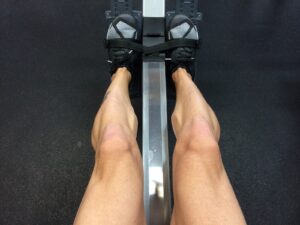Are you new to the rowing machine and looking for guidance on how to get started? Rowing is a low-impact exercise that provides a full-body workout, making it an excellent addition to any fitness routine. However, improper technique and common mistakes can lead to injuries or ineffective workouts. In this blog post, we will provide tips for setting up the rowing machine correctly, mastering the rowing technique, effective beginner workouts, and avoiding common mistakes for a safe and efficient rowing experience.
Table of Contents
Setting up the Rowing Machine Correctly
A proper setup of the rowing machine is essential for a safe and effective workout. First, ensure that the resistance level is appropriate for your fitness level. Beginners should start with a low resistance setting to avoid injury or strain. Adjust as needed once you’re comfortable with the motion.
Next, proper foot placement is crucial to maintain balance and prevent slipping off the machine mid-row. Your feet should be strapped in securely, flat on the footrests with toes pointing straight ahead. Avoid angling your feet inward or outward as it can lead to discomfort or even injury during an extended session on the rowing machine.
Adjusting the Resistance
Understanding the resistance level on your rowing machine is crucial to achieving a safe and effective workout. Gradual increments in resistance will help you build strength and endurance without risking injury. Different workout goals require different levels of resistance, so it’s important to adjust accordingly.
Here are some tips for adjusting the resistance on your rowing machine:
- Start with a low resistance level if you are new to rowing or haven’t exercised in a while.
- Increase the resistance gradually over time as your fitness improves.
- Use higher resistances for shorter, more intense workouts focused on building strength.
- Use lower resistances for longer workouts focused on building endurance.
By following these guidelines, you can ensure that your rowing workouts are safe and effective. Remember to always listen to your body, start slow, and adjust the resistance gradually over time.
Proper Foot Placement
Proper foot placement is essential for maintaining good posture and executing efficient strokes on the rowing machine. Before starting your workout, ensure that your feet are positioned securely on the footrests. Avoid common mistakes such as cramming or extending your feet too far onto the footrests, which can lead to discomfort and poor form.
Proper foot placement on a rowing machine is essential for good posture, efficient strokes, and minimizing the risk of injury.
To achieve proper foot placement, place your feet in a comfortable position with heels resting against the backstop. Flex your ankles slightly upward so that only the balls of your feet are in contact with the footrests. This ensures optimal power transfer during each stroke and reduces stress on your lower back.
By paying attention to proper foot placement, you can avoid common mistakes and reduce the risk of injury while maximizing results from each workout session on the rowing machine.
Mastering the Rowing Technique
To master the rowing technique, it’s essential to focus on proper form and execution. When beginning your rowing machine workout, start with a strong catch by sitting tall with shoulders relaxed and engaged core muscles. As you move into the drive phase of the stroke, push through your legs while keeping your back straight and arms extended. Finally, finish each stroke by leaning slightly back, pulling in your arms towards your chest.
Remember that mastering proper technique takes time and practice. Start slowly with shorter workouts to ensure safe execution before increasing intensity or duration. By following these tips for correct form during every stage of the rowing motion, beginners can achieve an effective full-body workout while minimizing the risk of injury or strain on their body.
The Catch
Maintaining proper posture with a straight back is crucial for the catch phase of rowing. This ensures that your spine is in alignment and reduces the risk of injury to your lower back. Bending your knees and sliding forward until shins are vertical allows you to achieve maximum power during the drive phase.
Gripping the handle with an overhand grip and keeping wrists flat helps prevent unnecessary strain on your forearms and hands. Remember, a proper catch sets you up for a smooth and effective stroke, so take time to master this foundational technique before moving on to more advanced workouts.
The Drive
Initiating power from your legs, rather than relying on your arms or back, is essential for a safe and effective rowing machine workout. To begin the drive, push off with your feet using the balls of your feet as you lean forward slightly and engage your core muscles. Focus on keeping proper form by aligning your shoulders above the hips.
As you continue through the drive phase, remember to keep pushing through your heels to move away from the footrests while maintaining proper alignment. Keep engaging those core muscles throughout each movement to prevent strain on other parts of the body and maintain control over the motion. By following these simple tips during “The Drive,” beginners can improve their technique, reduce risk of injury and enjoy more rewarding workouts!
The Finish
Leaning slightly back while extending your arms fully towards your chest, squeezing shoulder blades together at the end of arm extension, and pausing briefly before returning to starting position are all crucial elements of a proper finish on the rowing machine. These small adjustments can make a big difference in maximizing the effectiveness of your workout and preventing injury.
Here are some key tips to keep in mind during the finishing phase:
- Lean back slightly from vertical without losing good posture.
- Fully extend arms towards chest.
- Squeeze shoulder blades together at end of arm extension for maximum engagement.
- Pause briefly (1 second) before returning to starting position.
By incorporating these simple techniques into your rowing routine, you’ll be able to achieve a more efficient and effective workout while also reducing your risk for injury.
Effective Workouts for Beginners
Proper technique is key when starting out on the rowing machine. Begin with a warm-up routine that includes stretching and low-intensity rowing to prevent injury and improve flexibility. During your workout, maintain proper posture and focus on using your legs, core, then arms in that order to maximize efficiency.
As a beginner, start with a simple 20-minute steady-state rowing workout at moderate intensity. This will help you get comfortable with the motion of rowing while building endurance over time. As you progress, incorporate interval training by alternating between high- and low-intensity rows for shorter durations to increase cardiovascular fitness and burn more calories per session.
Warm-Up Routine
To prevent injury and prepare your body for an efficient workout, it’s important to have a warm-up routine before using the rowing machine. Start with dynamic stretches that target the major muscle groups used in rowing, such as leg swings and arm circles. This helps increase blood flow and range of motion.
Follow up with 5-10 minutes of light rowing at a low intensity to gradually increase your heart rate and warm up your muscles further. Lastly, practice proper posture by sitting tall on the seat with your shoulders down and back. Engage your core muscles to maintain stability throughout the workout.
Incorporating these simple yet effective warm-up exercises into your routine can help you avoid common mistakes while ensuring a safe and productive workout session on the rowing machine.
Beginner Rowing Workout
To master the catch position in rowing, start by sitting tall on the seat with your feet strapped in and hands holding onto the handlebar. Push off from the footplates to initiate the movement, then lean forward with a straight back to reach for your toes while keeping your knees bent. The focus should be on smooth and controlled movements throughout each stroke.
As a beginner, it’s important to gradually increase resistance over time as you build strength and endurance. Start with light resistance levels before progressing to heavier ones. Practice maintaining good form before increasing intensity or duration of workouts. With patience and consistency, you’ll be able to improve your technique and achieve better results on the rowing machine.
Interval Training
When it comes to interval training on the rowing machine, it’s important to start with short intervals such as 30 seconds. This allows your body to adjust and prevents injury. Additionally, using an ‘On’ vs ‘Off’ Time Ratio of 2:1 is an effective way for beginners to build endurance and increase their speed gradually.
While doing intervals, taking a ‘Paddle’ in between each one can help prevent injury by allowing your muscles time to recover before the next burst of activity. Remember that safety should always come first when working out on a rowing machine, so take breaks when needed and listen to your body’s signals.
Common Mistakes to Avoid
To ensure a safe and effective rowing machine workout, beginners should avoid common mistakes. One mistake to avoid is rounding your back during the stroke, which can lead to strain and injury. Instead, focus on maintaining good posture throughout the movement.
Another mistake to watch out for is relying too heavily on your arms rather than engaging your legs and core muscles. This not only limits the effectiveness of the exercise but also increases your risk of injury. Make sure you’re using proper technique by pushing with your legs first before pulling with your arms.
Lastly, don’t be tempted to go too fast too soon. Start with a comfortable pace and gradually increase as you build strength and endurance. Going too hard too quickly can result in burnout or even injury if proper form isn’t maintained throughout each stroke. Keep these tips in mind for a safe and effective introduction to the rowing machine!
Rounding Your Back
Engaging your core muscles is crucial when using the rowing machine to maintain proper posture and avoid rounding your back. Sitting tall with a straight back throughout the entire exercise will not only prevent injury but also improve your performance. Avoid hunching over and straining your lower back by following these tips:
- Keep your shoulders relaxed
- Draw in your belly button towards your spine
- Sit on the seat with hips level and feet securely fastened into the straps
Focusing on maintaining good form may take some practice, but it’s worth it for a safer, more effective workout.
Pulling with Your Arms Only
To get the most out of your rowing machine workout, it’s important to use your entire body in the movement. Don’t rely solely on pulling with your arms – engage your legs as well by driving through the heels to initiate each pull. This will not only give you a more effective workout, but also reduce strain on your arms and shoulders.
Think of rowing as a full-body exercise rather than just an arm workout. Keep your elbows close to your body and pull towards your midsection, engaging muscles in both your upper body and lower body simultaneously. By using proper technique and involving multiple muscle groups, you’ll be able to maintain good form throughout longer workouts without getting fatigued too quickly.
Going Too Fast Too Soon
When starting a rowing machine workout, it’s important to avoid going too fast too soon. It’s crucial to start at a slower pace before gradually increasing intensity or resistance. Building endurance takes time and rushing into an intense workout can result in injury or burnout. Remember, slow and steady wins the race.
It’s also essential to avoid sacrificing form for speed. Focus on technique first before trying to increase your speed. Maintaining proper posture throughout each stroke will help prevent back pain and ensure you get the most out of your workout. Lastly, always warm up properly before starting an intense workout to reduce your risk of injury and improve performance on the machine. By taking these steps, you’ll be able to have a safe and effective rowing experience that yields great results over time!



